ENAD History
From Where to Where?
Before the establishment of the ENAD, the deaf were faced with many problems. The society held the view that the deaf could not be educated. A deaf person was referred at as "Denquero" in the Amharic language, which means some one who could not be educated or an ignorant being. Opportunities for employment and other social activities were also none existent. While there existed a boarding school for the blind operated by the government, no government schools of any type were in existence for the deaf. There were, however, two schools for the deaf in Addis Ababa and another one in Keren, in present day Eritrea. All these schools were operated by religious missionaries.
It was not unusual for some families to associate having a deaf child as a curse from God. The negative and disparaging attitudes held by society towards the deaf coupled with the belief that deafness was a curse was more than enough reason for families to hide their deaf children from public view.
It was under such a situation that the ENAD came into being. The deaf needed an association through which they could advocate for their rights.
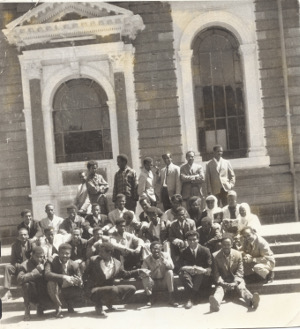
"We stood together for the common cause of deaf people
and for this Association."
The group of deaf persons who assembled to establish the ENAD
at the St. George Church
in September 1970 (1963 E.C.)
(Photo: From ENAD's archive)
(Click on photo for a bigger image and also names of the members.)
Some of the more enlightened deaf persons were agitating for the establishment of an association. At the time, establishing an association was a very risky undertaking. Associations of any kind were viewed with much suspicions by the government. So, it was with much gallantry that on 13 September 1970 (Meskerem 3, 1963 in the Ethiopian Calendar), a group of deaf persons and one hearing friend assembled in the compound of the St. George Church located at Menelik II Square and resolved to establish an association of deaf persons (Click here for a list of the founding members). Thus, the Ethiopian National Association of the Deaf (ENAD) was born. An executive committee composed of seven persons (five deaf men, one deaf woman and the hearing friend of the deaf who knew sign language) was elected.
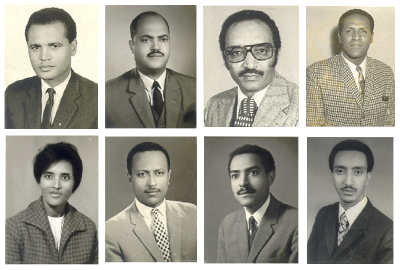
The members of the first board of the ENAD.
- H.E. Mr. Abebe Kebede
- H.E. Mr. Demssie M. Adefrsew
- H.E. Mr. Tesfaye Mekasha
- Mr. Hailemariam Woldekidan
- Mrs. Almaz Zewdie
- Mr. Wondimagegn Asfaw
- Mr. Esayas Asfew, and later
- Mr. Manikulih Shiferaw
(Photos: From ENAD's archives)
The ENAD had a board composed of high government officials, six of whom were hearing while one was deaf. They contributed a lot of their time and energies and gave the ENAD credibility at a time when the prevailing environment was not conducive to establishing associations.
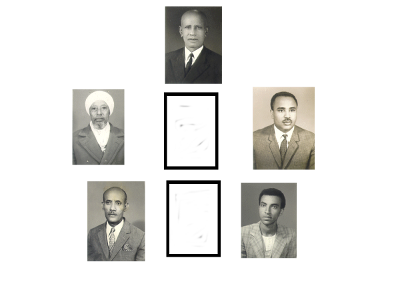
Some members of the parents' committee.
- Mr. Beyene Bezabih
- Memrie Tadesse Afras
- Mr. Mengistie Tessema
- Mr. Girma Fisseha
- Mr. Seid Ali
- Mrs. Abebech Tadesse
- Mr. Teklemariam Makonnen
(Photos: From ENAD's archives)
The ENAD had also a parents' committee composed of seven persons made up of parents, family members and friends of the deaf.
The over all work was being carried out by the executive committee. The committee used to receive guidance on government policy and other matters from the board.
This structure remained in place until a change of government took place in September 1974. However, the executive committee of the ENAD stayed in place almost unchanged until August 1977.
Activities carried out
During this time, the deaf were seen by society as incapable of being educated and unable to engage in any productive activities as narrated earlier. This was reflected by the word that was in use to refer to the deaf, a word that had nothing to do with deafness but rather referred to lack of mental capacity to learn or to be educated.
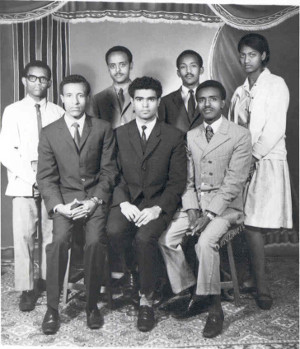
The first Executive Committee of the ENAD in 1970.
- Mr. Hailu Yesuneh
- Mr. Tesfaye Asnake
- Mr. Minasse Abera
- Mr. Teklehaimanot Derso
- Mr. Afework Mengesha
- Mr. Tesfaye Bantiwalu
- Ms. Simegn Woldeberhan
(Photo: From T. H. Derso's personal collection)
So, the first activity the ENAD undertook was a study to find out in what productive activities the deaf were engaged in. The deaf were engaged in many different productive activities. What is more, a few were even owners of their own enterprises and were giving employment opportunities to hearing persons.
It was decided to hold an exhibition of products made by the deaf as a way to change the mistaken attitudes society had on the deaf. In September 1971, the exhibition was organized and it was opened by His Majesty the Emperor. After the opening ceremony, the exhibition was left opened to the public for one week.
Deaf who were engaged in many different activities participated at the exhibition. Amongst them were: fine artists, a gold and silver smith, carpenters, tailors, a shoe factory owner, etc.
Funding problems
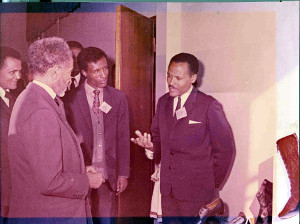
After opening the exhibition, His Imperial Majesty Haile
Selassie I listening to Mr. Beyene Kebede, one of the
founding members of the ENAD and who had a shoes factory
while H.E. Mr. Abebe Kebede (far left), ENAD Board
Chairman and Mr. Hailu Yesuneh, the ENAD Executive
Committee Chairman, look on. September 1971 (1964 E.C.)
(Photo: From ENAD's photo archive)

1971 (1964 E.C.): Princess Tenagnework inspecting gold and
silver works of Mr. Tesfaye Bantiwalu; buffet and wood
works of Mr. Getahun Kebede. In between is Mrs. Abebech
Tadesse, member of the committee of parents.
(Photo: From ENAD's Photo archive)
Following its study on the activities the deaf were engaged in, the ENAD had prepared two projects for small scale workshops in wood and leather products. These were meant to open employment opportunities for the deaf while also generating some income for the ENAD as a spin over for carrying out other activities. Unfortunately, it was not possible to implement the projects due to lack of funding.
The ENAD did not have any dependable source of income. Its only source was membership contributions. But, our members' capacity to contribute was very highly limited. The amount was very small at Birr 1.0 per month for many years. This low amount was further compounded by the fact that many of our members were not gainfully employed and thus were unable to pay.
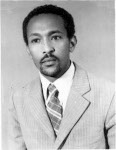
Mr. Tesfaye Bantiwalu (R.I.P)
who had made his Gold and Silver Shop
available to the ENAD Executive Committee
as a meeting place.
(Photo: From ENAD's Photo archive)
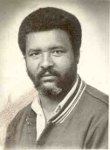
Mr. Getachew Gebrehiwot (R.I.P)
who had made his residence available for
the ENAD Executive Committee
as a meeting place.
(Photo: From ENAD's Photo archive)
The ENAD did not have a permanent address from where to operate. Initially, the committee was meeting at a cafe located at the City Hall. Later, it was meeting at two different places. One of our members, Mr. Tesfaye Bantiwalu, who is reported to have been one of the catalysts for the establishment of the ENAD was a member of the first executive committee of the ENAD. He was a gold and silver smith by profession. His shop was located at a most convenient place at the Abune Petros Square area of Addis Ababa, where most of the deaf used to hang around. So, every time the committee needed a place to meet, he welcomed the members to use his shop.
The second place where the committee used to meet was located near to the area where the members of the ENAD used to hold monthly meetings. It was at the home of Mr. Getachew Gebrehiwot. Although not a member of the first executive committee, he was a member of the committee that came after the first. The committee continued to meet at his home for a long time until it found a permanent location. Thus, it was a very big challenge to carry out the activities of the association due to lack of funds and a place to work from.
The providing of service to its members on a regular basis only started after arrangements were made by the ENAD Board for the salary of the chairman of the Executive Committee of the ENAD to be covered by the United Abilities Umbrella Factory. The factory was then employing persons with disabilities, many of them being deaf. The ENAD was also provided with a one room office at the Braille Library that was being operated by the Haile Selassie I Foundation. The salary of a typist was covered by one of our Board members. This arrangement continued until a few years after the eruption of the revolution in 1974.
In 1974, some time before the eruption of the revolution, it was communicated to the ENAD by its Board Chairperson about the granting to the ENAD of two shares from the Addis Ababa Abattoir. Unfortunately, the ENAD heard nothing more about the matter since the abattoir was nationalized after the revolution. Thus, the ENAD has received nothing from the government of the emperor.
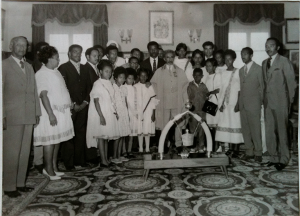
Some of our deaf members, board, executive
and parents committee members with HIM in July 1973
(Click on photo for a bigger image)
(Photo: From ENAD's Photo archive)
That the ENAD got nothing from the government was not due to absence any efforts on the part of its officials. At the time, nothing could be done without His Majesty the Emperor's say. One reason for the organization of the exhibition was to gain his attention. But, that did not seem to have worked. So, the ENAD requested an audience in order to wish him happy birthday and also presented him with a gift on his 81st birthday. The ENAD had commissioned one of its members, a gold and silver smith, to make the gift and it was made from two elephant tusks, bound with silver and set on a pedestal. Hanging from the elephant tusks was a likeness of the Imperial crown. It was some months after this event that the ENAD was informed about the two shares.
After the one room office was secured, there was a problem with furniture. This was solved due to a small but very valuable donation that was received from the [Ethiopian Child and Family Welfare Association ???], which enabled the ENAD to buy some tables, a shelf and chairs.
Unlike now, non-governmental organizations engaged in charitable and development activities did not exist then. There was the Haile Selassie I Foundation. But, its activities were only directed at the blind and older persons. Its activities did not include the deaf. There were also development organizations like the USAID, DANIDA, FINIDA, SIDA, but they only supported projects that were identified by the government. There was also Save the Children from Norway, but its focus was on children. Even then, it is uncertain if it ever dealt with deaf children. Because of this prevailing situation, the ENAD did not have any source of funding except the meagre amount of money it was collecting as membership fee.
So, the ENAD undertook its first fund raising activity in the form of a musical festival. Professional musicians from the Imperial Honor Guards, the Ground Forces and the Police very kindly agreed to participate and the festival was held during one afternoon at the Ambassador Theatre. Unfortunately, after paying for hall rent, taxes and other expenses, the fund generated was not big enough to carry on any of the projects.
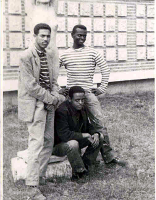
First batch of deaf fine artists who studied
at the Addis Abab Fine Arts School
(Photo from: ENAD archive)
Although there did not exist any education policy directed at the deaf, there was one school in Addis Ababa that accepted some deaf students. It was the Addis Ababa Fine Arts School. It used to admit its students by giving them a one month training during the summer and then select those who showed promising talent. What is more, during that period, the school had a director who was a foreigner and thus unbiased by hearing talk about the deaf being incapable of being educated. So, some of the deaf were able to get enrolled through this route. A few others were also enrolled through the direct orders of the Emperor. Thus, the ENAD had more than ten fine artists as members.
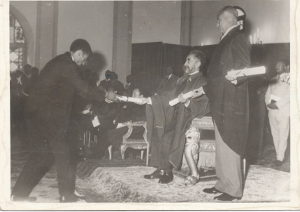
Yohannes Tsegaye receiving his diploma from
His Imperial Majesty Haile Selassie I on
Hidar 4, 1965 E.C. (12 November 1972)
(Click on photo for a bigger image)(Photo from: ENAD archive)
Exhibitions of fine arts by deaf fine artists were held many times. Some of the venues that were used were the then American School that was located near the old airport, The City Hall, The Goethe Institute and other places. However, only the exhibition that was organized at the Goethe Institute could be said to have generated some income to our deaf fine artists. That was because it was very well organized and attended. Apart from the income, these exhibitions did showcase fine arts works by deaf artists.
The ENAD has been advocating for the special needs of the deaf since its establishment. During the Derg regime, it had some success in gaining the attention of some of the top leaders of the Derg. Unfortunately, the frequent and violent changes at the top of the leadership were not conducive to the ENAD getting much attention. It was very difficult to get decisions that were passed by previous leaders to be adopted and implemented by the new ones.
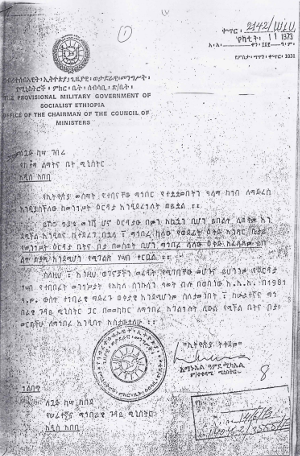
Letter from the Council of Ministers of
The Provisional Military Government of
Socialist Ethiopia date 18 February 1981
(11 Yekatit 1973 E.C.)
(Click on photo for a bigger image)
(Photo from: ENAD archive)
Still, the ENAD persisted in raising and reminding the authorities about the special needs of the deaf. After some years, it was possible for ENAD's request to make it to the Council of Ministers. The council of Ministers, sent one of its members, His Excellency Ato Wole Chekol, to pay a visit to the ENAD, where he was briefed by the ENAD officials about the dire needs of the deaf and the ENAD itself.
Some time after this, the ENAD learned that the Council of Ministers had decided for The Ministry of Labor and Social Affairs, The Ministry of Urban Development and Housing and The Ministry of Health to provide assistance to the ENAD in areas falling under their respective authorities. Then, a very protracted fight commenced and continued for a long time with lower level officials to get the decisions passed by the Council to be implemented.
The ENAD did not have any problems with the Ministry of Labor and Social Affairs as the Ministry and its officials have always been on the side of the ENAD. So, the Ministry implemented its part of the government decision by having the Rehabilitation Agency for the Disabled to support the ENAD through various ways, including covering the salaries of the staff members of the ENAD.

Letter from the Ministry of Urban Development
and Housing of The Provisional Military Government
of Socialist Ethiopia date 1 April 1983
(23 Megabit 1975 E.C.)
(Click on photo for a bigger image)
(Photo from: ENAD archive)
The biggest problem the ENAD faced was while dealing with some low level officials of the Ministry of Urban Development and Housing. Dealing with land and housing matters has always been fraught with problems and open to corrupt practices. The problem was with lower officials dragging their feet implementing the decisions passed by their higher officials and some times even misplacing files. While the decision clearly stated that the ENAD was to be assisted and the house it had identified was given to it free of rent, on more than two occasions, it was asked to pay rent at the pain of being evicted.
It was in this way the ENAD was able to get the assembly hall and the house where it is quartered now. However, the decision that was passed by the Council of Ministers was to give the ENAD not only a house but also land. However, it was not resolved for a long time. Finally, a plot of land was given to the ENAD that was located near its current headquarters. Unfortunately, the ENAD was not able to develop it due to lack of funds. So, the City Administration took the land and gave it to another entity and has now been used for the construction of a mosque.
Following the ENAD's complaint that it needs special treatment and that the time cap of six months for developing a site ought not to apply to it as it is a not for profit association of deaf persons carrying out activities that support what the government is doing, it was decided to give it another plot of land. But, this plot of land was located at the Bole Bulbula area, which is very far away from the center of the city. As the deaf are scattered all over the city, the location at Bole Bulbula is not accessible to all the deaf. What is more, many students of the Addis Ababa University do research work related to the deaf, sign language, education of the deaf, employment of the deaf and other social, psychological and other aspects related to the deaf. The current location of the ENAD is idly suited for such activities in addition to it being very accessible to the deaf. So, a replacement plot of land needs to take such factors into account. For the above mentioned reasons, the ENAD declined the offer of the plot of land at Bole Bulbula. It is still hoping that it would be given a plot at a more favorable location.
